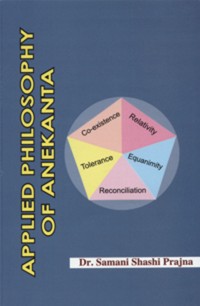Kundkunda says, those who assert absolute permanence or dhrauvya nature of Reality, two types of transgressions may occur. Firstly, modes will cease. If modes are destroyed, then reality bereft of modes cannot exist at all. So the occasion of destruction of Reality may occur. Secondly the permanent nature of reality converts as impermanent, if we accept the absolute destruction of dhrauvya nature of reality.[1]
As per Umāsvāti's Sabhasya Tattvārthādhigama Sūtra, if we accept absolute permanent nature of a Reality like Vedanta philosophy, then soul will remain static in its own one inherent nature. No difference in its states will occur. In the absence of change in the states of soul, the difference of saṁsāra and mokṣa will never occur.
utpādādiyute khalu vastunyetadupapadyate sarvaṁ,
tadrahite tadabhāvāt sarvamapi na yujyate nītyā[2]
If one considers this difference of saṁsāra and mokṣa as mere imaginary, then one has to accept the soul bereft of any sort of inherent nature of its own. Because saṁsāra and mokṣa are also the nature of soul. When we consider the soul's nature saṁsāra and mokṣa and its changing state as imaginary then, one is compelled to agree with the natureless and imaginary existence of the soul also. If one denies any nature of soul, and in the absence of its nature, one is bothered to accept non-existence of the soul itself.
As quoted in the Sanmatitarka of Siddhasena Gaṇī (6th cent. A.D.) that,
suha-dukkhasaṁpaogo ṇa jujaye ṇiccavāya pakkhāmmi,
eghaṅtucchedeyammi ya suha-dukuhaviyappaṇamajuttaṁ.[3]
From the point of view of those, who hold that an entity is unchangeable, happiness and misery cannot stand; in the opinion of those who hold that things eternally change the idea of happiness and misery can never hold good. Moreover, Siddhasena continued to raise problems in the next stanzas that:
kammaṁ joganimittaṁ bajjhe baṅdha-ṭṭhiē kasāyavasā,
apariṇaucchiṇesu ya baṇdha-ṭthikāraṇam ṇatthi.
baṇdhammi apūrante saṁsārbhavogadansaṇaṁ mojjhaṁ,
baṇdhaṁ va viṇā mokkhasuhapatthaṇā ṇatthi mokkho ya.[4]
It means,'Action current' (yoga) attaches or binds a man through mind, speech and body. And it is through our passions (ka·āyas), that this action-current binding a man takes its firm stand. But if we think that a thing is eternally unchangeable or when we think, the thing is born and in a moment decays, we can never account for the binding of an action or its continuance. If there is no binding by action current, then it will be a folly to desire the happiness of the liberation. In fact, then there cannot be any such thing as liberation at all.
Samantabhadra also quoted the very same idea against ekantavāda in Āptamīmaṁsā as:
puṇyapāpakriyā na syāt pretyabhāvaḥ phalaṁ kṛtaḥ,
bandhamokṣau ca teṣāṁ na yeṣāṁ tvaṁ nāsti nāyakaḥ.[5]
It means that, the person who accepts absolute eternal nature of a reality, there will be no possibility of virtuous or sinful acts. Then how can there be rebirth as fruition of the same. O Lord! Then you cannot establish bondage or liberation too.
Devanandī says, the dhrauvya nature of nitya (permanent) object is the cause of recognition. The remembrance that, this is the same thing I saw yesterday, is recognition. That does not occur accidentally. That which is the cause of such a statement is its intrinsic nature (tadbhava). Tadbhava is its existence. A thing is seen as having the same nature with which it was seen formerly. So it is recognized through the form, 'This is the same as that'. If it is considered that the old thing has completely disappeared and that an entirely new thing came into existence, then there will be no room for remembrance. And worldly relations which are based on it, would get disturbed. Therefore, the indestructibility of the essential nature of a substance is determined as permanence. But it should be taken from one point of view. If it is taken as permanent from all points of view, then there can be no change at all. And, in that case, transmigration as well as the way to salvation would become meaningless. Transmigration of the soul as a man and the liberation, i.e. the end of transmigration, would both be impossible.[6]
Transgressions in Accepting Absolute Momentary Nature of Reality
Ācārya Samantabhadra discusses the transgressions occurring due to the acceptance of absolute momentary nature of sat. He says,
kṣaṇikaikāntapakṣepi pretyabhāvādyasambhavaḥ,
pratyabhijñādyabhāvanna kāryārambhaḥ kutaḥ phalaṁ.[7]
In the view of those who accept kṣaṇaikānta (absolute momentaryness), existence after death etc. is impossible. As there will be no pratyābhijñā (This is that only), this kind of recognition or memory etc., is impossible. There cannot be any beginning of any effect leading to any result. It means, if a man does not remember his previous experience, how will he act to satisfy his desire by doing necessary acts. One collects firewood, cooking pot, rice and water, wishing to cook food, without pratyabhijñyā (recognition); this action (kāryarambha) can never take place, and the fruits of the act (phala) can consequently never happen. Another argument is preferred against the Buddhists in this verse.
na hetuphala bhāvadiranyabhāvādananvayāt,
santānāntaravannaikaḥ santanastadvataḥ pṛthak.[8]
Here, Samantabhadra refutes the view of the Buddhist kṣanaikavāda, recognizing different moments and unconnected with one another, but taking rise one after another is untenable. Being different and unconnected, relationship of cause and effect cannot exist, as one cannot be like another santāna (write). Hemachandra (1088-1172) also raised many objections. He says:
naikāntavāde sukhadukhabogau na punyapāpe na ca bandhamokṣau,
durnitivāda-vyasanāsinaiva, parairviluptaṁ jagadapyaśeṣaṁ.[9]
It means, if we accept the nature of sat (reality) as absolute eternal or absolute non-eternal, then we can't explain the experiences of pleasure and pain, merit and sin, bondage and liberation. The triple nature of sat if analyzed deeply, can explain obviously above mentioned questions or problems in a right perspective.
 Dr. Samani Shashi Pragya
Dr. Samani Shashi Pragya

